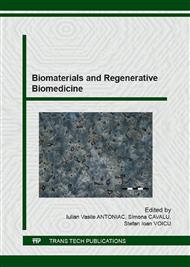[1]
G.H. Altman, F. Diaz, C. Jakuba, T. Calabro, R.L. Horan, J. Chen, H. Lu, J. Richmond, D.L. Kaplan, Silk-based biomaterials, Biomaterials 24 (2003) 401-416.
DOI: 10.1016/s0142-9612(02)00353-8
Google Scholar
[2]
Y. Wang, D.D. Rudym, A. Walsh, L. Abrahamsen, H.J. Kim, H.S. Kim, C. Kirker-Head, D.L. Kaplan, In vivo degradation of three-dimensional silk fibroin scaffolds, Biomaterials 29 ( 2008) 3415-3428.
DOI: 10.1016/j.biomaterials.2008.05.002
Google Scholar
[3]
J. Qu, D. Wang, H. Wang, Y. Dong, F. Zhang, B. Zuo, H. Zhang, Electrospun silk fibroin nanofibers in different diameters support neurite outgrowth and promote astrocyte migration, J. Biomed. Mater. Res. A. 101 (2013) 2667-2678.
DOI: 10.1002/jbm.a.34551
Google Scholar
[4]
Y. Ruan, H. Lin, J. Yao, Z. Chen, Z. Shao, Preparation of 3D fibroin/chitosan blend porous scaffold for tissue engineering via a simplified method, Macromol. Biosci. 11 (2011) 419-426.
DOI: 10.1002/mabi.201000392
Google Scholar
[5]
L. Uebersax, H. Hagenmüller, S. Hofmann, E. Gruenblatt, R. Müller, G. Vunjak-Novakovic, D.L. Kaplan, H.P. Merkle, L. Meinel, Effect of scaffold design on bone morphology in vitro, Tissue. Eng. 12 (2006) 3417-3429.
DOI: 10.1089/ten.2006.12.3417
Google Scholar
[6]
K.H. Kim, L. Jeong, H.N. Park, S.Y. Shin, W.H. Park, S.C. Lee, T.I. Kim, Y.J. Park, Y.J. Seol, Y.M. Lee, Y. Ku, I.C. Rhyu, S.B. Han, C.P. Chung, Biological efficacy of silk fibroin nanofiber membrane for guided bone regeneration, J. Biotechnol. 120 (2005).
DOI: 10.1016/j.jbiotec.2005.06.033
Google Scholar
[7]
S.A. Oh, G.S. Lee, J.H. Park, Osteoclastic cell behaviors affected by the α-tricalcium phosphate based bone cements, J. Mater. Sci. Mater. Med. 21 (2010) 3019-3027.
DOI: 10.1007/s10856-010-4152-z
Google Scholar
[8]
J.L. de Moraes Machado, I.C. Giehl, N.B. Nardi, L.A. dos Santos, Evaluation of scaffolds based on α-tricalcium phosphate cements for tissue engineering application, IEEE. Trans. Biomed. Eng. 58 (2011) 1814-1819.
DOI: 10.1109/tbme.2011.2117425
Google Scholar
[9]
Y. Qu, Y. Yang, J. Li, Z. Chen, J. Li, K. Tang, Y. Man, Preliminary evaluation of a novel strong/osteoinductive calcium phosphate cement, J. Biomater. Appl. 26 (2011) 311-325.
DOI: 10.1177/0885328210371241
Google Scholar
[10]
C. Correia, S. Bhumiratana, L.P. Yan, A.L. Oliveira, J.M. Gimble, D.N. Rockwood, D.L. Kaplan, R.A. Sousa, R.L. Reis, G. Vunjak-Novakovic, Development of silk-based scaffolds for tissue engineering of bone from human adipose-derived stem cells, Acta. Biomaterialia. 8 (2012).
DOI: 10.1016/j.actbio.2012.03.019
Google Scholar
[11]
B.W. Thimm, S. Wüst, S. Hofmann, H. Hagenmüller, R. Müller, Initial cell pre-cultivation can maximize ECM mineralization by human mesenchymal stem cells on silk fibroin scaffolds, Acta. Biomaterialia. 7 (2011) 2218-2228.
DOI: 10.1016/j.actbio.2011.02.004
Google Scholar
[12]
S. Bhumiratana, W.L. Grayson, A. Castaneda, D.N. Rockwood, E.S. Gil, D.L. Kaplan, G. Vunjak-Novakovic, Nucleation and growth of mineralized bone matrix on silk-hydroxyapatite composite scaffolds, Biomaterials 32 (2011) 2812-2820.
DOI: 10.1016/j.biomaterials.2010.12.058
Google Scholar
[13]
K. Makaya, S. Terada, K. Ohgo, T. Asakura, Comparative study of silk fibroin porous scaffolds derived from salt/ water and sucrose/ hexafluoroisopropanol in cartilage formation, J. Biosci. Bioeng. 108 (2009) 68-75.
DOI: 10.1016/j.jbiosc.2009.02.015
Google Scholar
[14]
D.N. Rockwood, R.C. Preda, T. Yücel, X. Wang, M.L. Lovett, D.L. Kaplan, Materials fabrication from Bombyx mori silk fibroin, Nature Protocols 6 (2011) 1612-1631.
DOI: 10.1038/nprot.2011.379
Google Scholar
[15]
M. Kitamura, C. Ohtsuki, S. Ogata, M. Kamitakahara, M. Tanihara, Microstructure and bioresorbable properties of α-TCP ceramic porous body fabricated by direct casting method, Materials Transactions 45 (2004) 983-988.
DOI: 10.2320/matertrans.45.983
Google Scholar
[16]
V. Karageorgiou, D.L. Kaplan, Porosity of 3D biomaterial scaffolds and osteogenesis, Biomaterials 26 (2005) 5474-5491.
DOI: 10.1016/j.biomaterials.2005.02.002
Google Scholar
[17]
L.P. Yan, J.M. Oliveira, A.L. Oliveira, R.L. Reis, In vitro evaluation of the biological performance of macro/micro-porous silk fibroin and silk-nano calcium phosphate scaffolds, J. Biomed. Mater. Res. B Appl. Biomater. 28 (2014) 1-11.
DOI: 10.1002/jbm.b.33267
Google Scholar
[18]
Y. Zhang, C. Wu, T. Friis, Y. Xiao, The osteogenic properties of CaP/silk composite scaffolds, Biomaterials 31 (2010) 2848-2856.
DOI: 10.1016/j.biomaterials.2009.12.049
Google Scholar
[19]
L.P. Yan, J. Silva-Correia, C. Correia, S.G. Caridade, E.M. Fernandes, R.A. Sousa, J. F. Mano, J.M. Oliveira, A.L. Oliveira, R.L. Reis, Bioactive macro/micro porous silk fibroin/nano-sized calcium phosphate scaffolds with potential for bone-tissue-engineering applications, Nanomedicine 8 (2015).
DOI: 10.2217/nnm.12.118
Google Scholar


